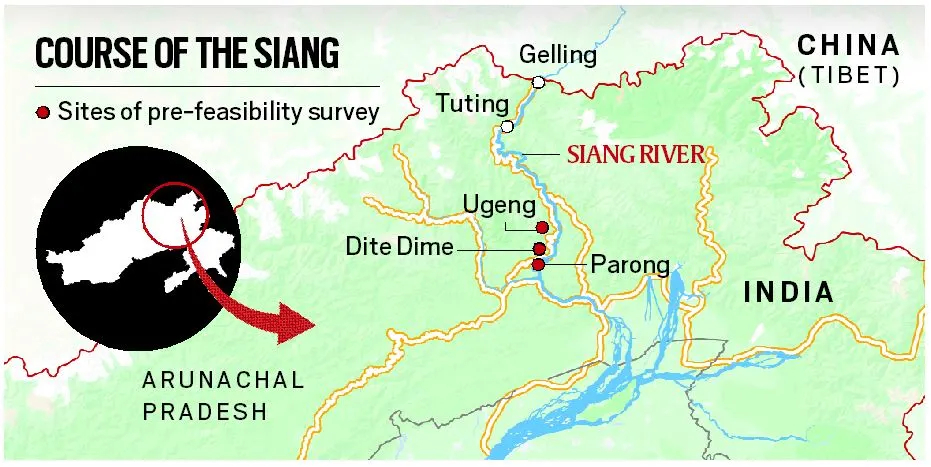Note4Students
From UPSC perspective, the following things are important :
Prelims level: Upper Siang; Brahmaputra River.
Why in the News?
Activists are protesting against the Upper Siang Hydropower Project in Arunachal.

About Upper Siang Multipurpose Storage Project
- The Upper Siang project is a proposed 11,000 MW hydropower project on the Siang River in Arunachal Pradesh.
- The Siang, originating near Mount Kailash in Tibet (Tsangpo), flows over 1,000 km eastward, enters Arunachal Pradesh as the Siang, and later becomes the Brahmaputra in Assam.
- Initially proposed as two separate projects, it was consolidated into one larger project in 2017, to be built by the National Hydroelectric Power Corporation (NHPC), featuring a 300-metre high dam.
Strategic Importance:
- The Upper Siang project is seen as a strategic move to counter China’s hydel projects on the Tsangpo, particularly a 60,000 MW ‘super dam’ in Tibet’s Medog county.
- This super dam’s capacity is nearly 3x that of the Three Gorges Dam in China and is intended to divert water to northern China.
Environmental and Social Concerns
- Anti-dam organizations express concerns about the project’s environmental and social impact in their memorandum.
- The memorandum highlights the threat to delicate ecosystems, wildlife habitats, and biodiversity in Arunachal Pradesh, which already hosts numerous dams.
- The activists are particularly worried about the displacement of communities, as the project could submerge over 300 villages of the Adi tribe, including the district headquarters of Yingkiong.
- Activists are also wary of the project’s portrayal as a national interest endeavor and are troubled by a provision in the Forest (Conservation) Amendment Act, which exempts strategic projects within 100 km from India’s borders from clearance requirements.
Back2Basics: Forest (Conservation) Amendment Act, 2023
|
PYQ:[2011] The Brahmaputra, Irrawady and Mekong rivers originate in Tibet and flow it through narrow and parallel mountain ranges in their upper reaches. Of these rivers, Brahmaputra makes a “U” turn in its course to flow into India. This “U” turn is due to: (a) Uplift of folded Himalayan series (b) Syntaxial bending of geologically young Himalayas (c) Geo-tectonic disturbance in the tertiary folded mountain chains (d) Both (A) and (B) above |
Get an IAS/IPS ranker as your 1: 1 personal mentor for UPSC 2024

